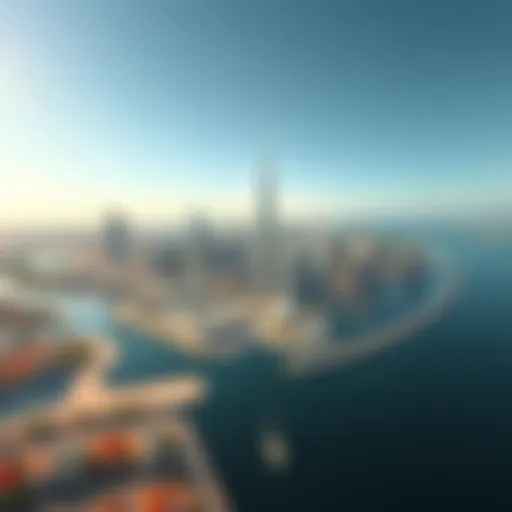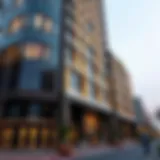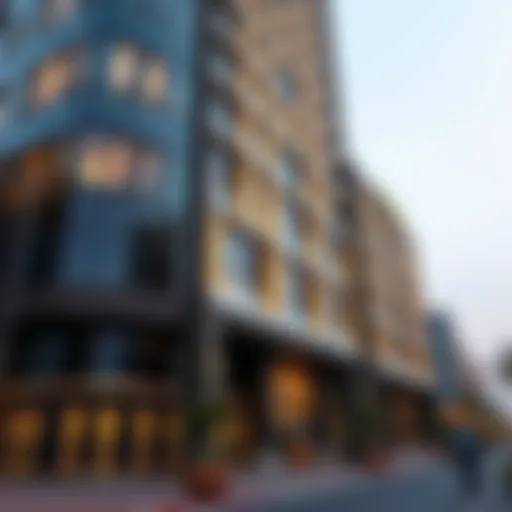Exploring the Dubai Red Line Metro Stations Guide
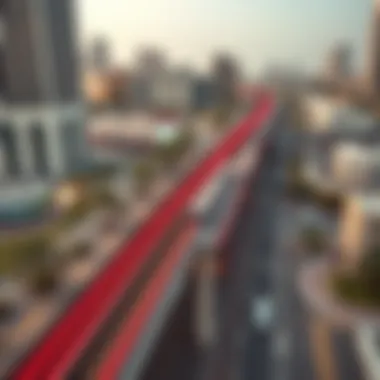

Intro
When it comes to urban living, Dubai has set itself apart with a transit system that's as modern as it gets. The Red Line of the Dubai Metro not only serves as a thread running through the metropolis but also ties together the fabric of its real estate landscape. This isn’t just about hopping on a train; it's about understanding how these stations can shape one’s journey and investment decisions.
As we meander through the various Red Line stations, we’ll delve into their unique characteristics, their proximity to iconic landmarks, and how they help steer the property market. Each station tells a story that goes beyond convenience—it's a narrative steeped in potential for property investment, urban development, and lifestyle enhancements. We aim to unravel these narratives and provide insights that empower different stakeholders—whether you’re an investor eyeing hotspots, a homeowner seeking comfortable living, or a commuter hoping to find ease in travel.
Here's what we’ll cover:
- Current trends impacting Dubai's real estate market.
- Predictive analysis on where developments are headed.
- Investment opportunities across various neighborhoods along the Red Line.
- Useful tips particularly for first-time investors looking to navigate this vibrant market.
By taking a closer look at the intricate ties between transportation and real estate, our goal is to arm you with knowledge and insights that go beyond the surface. Let’s kick things off with an exploration of current trends within the Dubai real estate market.
Preface to Dubai's Metro System
Dubai's Metro system stands as a hallmark of modern urban transit, weaving through the city's vibrant fabric while offering an efficient means of transportation. Launched in 2009, this ambitious project showcases Dubai's commitment to innovation, seamlessly connecting key areas of the city. As more than just a mode of public transport, the metro represents a critical component of Dubai's urban planning and economic strategy.
The rise of the metro is closely linked to Dubai's rapid growth and transformation into a global business hub. By providing a reliable alternative to road transport, the metro not only alleviates traffic congestion but contributes to environmental sustainability, reducing the carbon footprint associated with daily commuting. The convenience of the metro makes it a favored choice among both residents and visitors, underscoring its importance in everyday life within the city.
This intricate system consists of two main lines—the Red Line and the Green Line—spanning a combined length of over 75 kilometers. The Red Line, in particular, is pivotal, running from Rashidiya to UAE Exchange and beyond, with stations strategically positioned near major commercial centers and tourist attractions. This focus on accessibility ensures that the metro is not merely a transit route but a facilitator of economic activity and tourism.
Benefits and Features
Several key benefits round off the appeal of Dubai's Metro:
- Efficiency: Trains run every few minutes, ensuring swift travel and minimal waiting times.
- Affordability: The pricing structure caters to various segments, making it accessible for tourists and locals alike.
- Safety and Comfort: Modern trains provide a clean, safe, and comfortable environment for passengers, equipped with amenities like air conditioning and designated areas for women and children.
- Integration with Other Transport: The metro connects seamlessly with buses, taxis, and trams, creating a comprehensive public transport ecosystem that simplifies commuting for residents.
The metro affects not just mobility but also encourages urban development around its stations. As the train pulls into a station, possibilities arise. The proximity to metro stations has become a significant factor influencing real estate prices, as investors and developers recognize the value of being within walking distance to this essential service.
In summary, the introduction of Dubai's Metro system goes beyond transportation; it’s a transformative force designed to enhance urban living. Understanding this system's intricacies and its implications is essential for anyone wishing to navigate Dubai's dynamic landscape—especially for investors, homeowners, and realtors keen on capitalizing on the evolving market.
Overview of the Red Line
The Dubai Red Line stands as a cornerstone of the city’s ambitious metro system, which has become integral to how residents and visitors navigate the bustling streets of this cosmopolitan hub. Launched to facilitate efficient public transport, the Red Line connects key districts, commercial centers, and tourist attractions, ultimately enhancing the accessibility and livability of Dubai. As urban sprawls often lead to increased congestion, the importance of an efficient metro line cannot be overstated. It serves as a reliable alternative to traditional road transport, alleviating traffic woes while promoting eco-friendly commuting options.
Length and Coverage
Stretching over 52 kilometers, the Red Line runs from the Rashidiya Station in the east to the UAE Exchange Station on the outskirts of Abu Dhabi. Not only does it encompass an impressive 29 stations, but it also traverses some of the most populous and dynamic areas in the city. This strategic positioning makes it vital to connecting disparate neighborhoods and enhancing overall connectivity. For those who live and work along its route, the Red Line significantly reduces travel times, allowing for more leisure and productivity.
Furthermore, the Red Line is tailored to ease access to key commercial hubs, including Dubai Marina, Jumeirah Lakes Towers, and the world-renowned Burj Khalifa/Dubai Mall. Particularly for expatriates and residents alike, the line is a game changer, as it brings within reach not just workplaces, but also a variety of leisure and lifestyle options.
Operational History
The Red Line's operational history began in 2009, marking a significant milestone in Dubai's journey towards modernization. The inauguration launched Dubai into a new era of public transport, showcasing the emirate's commitment to smart urban planning. Initially, the line operated with a limited number of stations, but as demand grew, so did its offerings. Over the years, expansions included revamped stations and enhanced services to cater to the increasing number of passengers.
Attesting to its popularity, the Red Line has seen ridership soar, becoming essential for daily commuters and tourists. In its early days, apprehension regarding the metro's usage was notable; however, with time, more individuals embraced the convenience, leading to record numbers of passengers midweek and on weekends alike. In sum, the evolution of the Red Line underscores not just the growth of a transport infrastructure but also reflects the spirit of innovation flowing through Dubai.
"The Red Line is more than just a means of transport; it’s the lifeblood of urban mobility in Dubai."
Key Stations on the Red Line
The Red Line of Dubai Metro is a lifeline connecting various parts of the city. In order to appreciate its impact, one must delve into its key stations. Each of them embodies unique attributes that cater to the needs of travelers and contribute to the urban fabric of Dubai. Understanding these stations enhances the experience for daily commuters and investors alike, shedding light on areas with promising real estate opportunities.
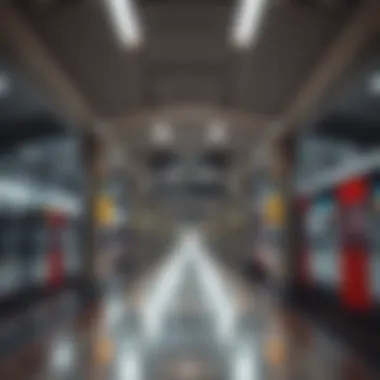

UAE Exchange Station
Location and Access
UAE Exchange Station is strategically located near the bustling financial district of Dubai. This station serves as a convenient gateway for both expatriates and natives, offering easy access to essential services. Commuters can hop off right next to considerable office spaces and business hubs. However, the layout can feel a bit crowded during peak hours, which may be a slight downside for some travelers.
Nearby Landmarks
This station is in proximity to a few noteworthy landmarks that showcase Dubai's modernity. The Dubai Festival City Mall stands out, offering both shopping and entertainment options. Additionally, it’s not far from the iconic Dubai Creek, which attracts tourists and locals alike. These landmarks enhance the region's allure, making it an attractive spot for potential investments. On the flip side, growing foot traffic could also lead to challenges in navigating the area.
Real Estate Implications
The presence of UAE Exchange Station significantly influences real estate dynamics. Properties nearby tend to see a consistent demand, especially among those who prioritize convenience. The accessibility offered by the station highlights the area's investments appeal. While the prices might be on the higher side, the long-term prospects indicate good value for investors. Still, it's crucial for homeowners to be mindful of market fluctuations, as rapid developments could sway local property valuations.
Dubai Marina Station
Location and Access
Dubai Marina Station is nestled in one of the city’s most picturesque locales, making it a hub for both tourists and locals. The access to various modes of transport here is noteworthy. This station connects directly to the waterfront and allows passengers to enjoy stunning views. However, it can get bustling, particularly on weekends, which may require patience during boarding and disembarking.
Nearby Landmarks
This station is surrounded by a plethora of landmarks that enrich the experience for visitors. The Marina Walk and Jumeirah Beach Residence are just a stone’s throw away. These areas are known not just for their beauty but also for dining and leisure options. The advantage of this vibrant atmosphere can be a major draw for those looking to invest in properties in the region. Unfortunately, the lively environment might also pose challenges in terms of noise and congestion for some residents.
Real Estate Implications
With its stunning views and vibrant lifestyle, the real estate market around Dubai Marina is thriving. Property values in this area have seen steady appreciation. Investors eyeing the waterfront properties will find a goldmine of opportunities here. Yet, prospective buyers must conduct thorough research, as competition can be fierce in this desirable locale. With the influx of new developments, potential investors can expect varied pricing, concerning the type of accommodation they seek.
Burj Khalifa/Dubai Mall Station
Location and Access
Located at the heart of Dubai, the Burj Khalifa/Dubai Mall Station is perhaps one of the most recognized stops on the Red Line. The accessibility here is unmatched, linking commuters directly to the Dubai Mall, one of the world’s largest shopping destinations. It's a favored stop for tourists, particularly due to the iconic Burj Khalifa nearby. This esteemed location, however, can also contribute to heavy foot traffic and limited parking options.
Nearby Landmarks
Being adjacent to the Dubai Mall and the Dubai Fountain makes this station extremely appealing. These landmarks are significant not just for leisurely visits but also for attracting businesses and tourists. The benefits of being near these attractions cannot be understated. Yet, the constant influx of visitors can create a bustling atmosphere that may deter those seeking peace and quiet.
Real Estate Implications
The real estate market around the Burj Khalifa/Dubai Mall Station is exceptionally vibrant. Properties here are certainly among the most coveted in Dubai, fetching premium prices. The proximity to such high-value landmarks has a significant positive impact on property valuation. However, potential buyers should be prepared for a competitive market, as availability tends to be limited.
Al Jafiliya Station
Location and Access
Al Jafiliya Station offers access to the more traditional side of Dubai. Positioned near several government offices, it caters to a diverse group of commuters. The station’s access contributes to its utility, making it a popular choice for those working in administrative roles. Unlike some of the other stations, this area tends to be relatively less crowded, which can be a boon for individuals seeking a straightforward travel experience.
Nearby Landmarks
Close to Al Jafiliya, you'll find the Dubai World Trade Centre. This landmark is a hub for various events and exhibitions, attracting a significant crowd. This surrounding aura of activity fosters a more professional atmosphere compared to other lively districts. Yet, with fewer entertainment options nearby, it may not stand out to tourists as much as other stations.
Real Estate Implications
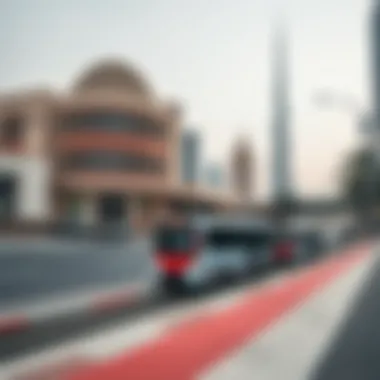
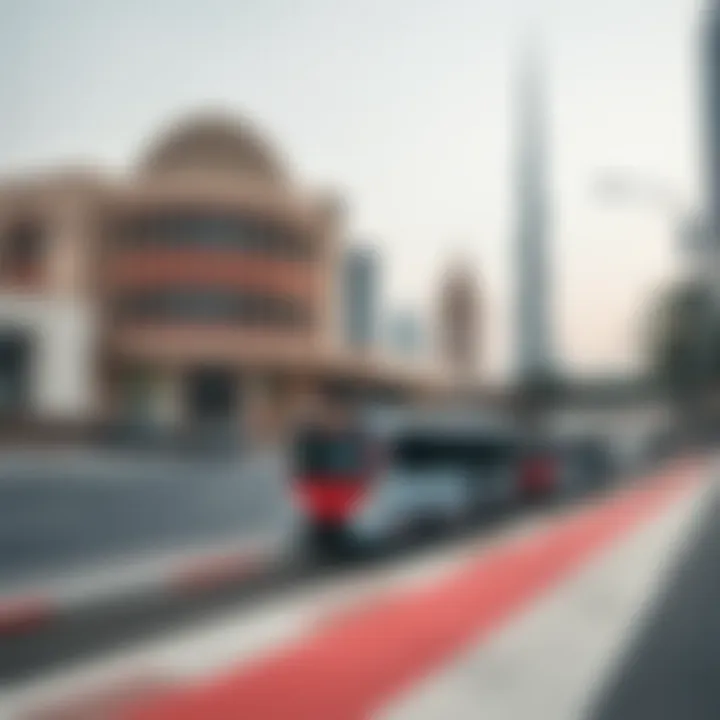
The real estate market surrounding Al Jafiliya Station remains fairly stable, appealing to those looking for commercial and professional spaces. Rental properties may often yield decent returns, especially for businesses looking for proximity to government services. However, the overall demand can be inconsistent due to its location, drawing a relatively niche market for property investments.
Rashidiya Station
Location and Access
Rashidiya Station is positioned strategically for those heading towards the quieter, more residential areas of Dubai. The station is well-connected, allowing easy transitions for commuters heading to the suburbs. This accessibility opens up options for families and those seeking a more peaceful living environment.
Nearby Landmarks
While there are fewer landmarks directly surrounding Rashidiya Station, the nearby Dubai Airport Free Zone does attract a fair bit of traffic. The proximity to the airport also adds a layer of convenience, especially for business travelers. On the downside, the lack of more vibrant attractions may limit the appeal for those looking for active nightlife.
Real Estate Implications
Properties close to Rashidiya Station generally serve a more family-oriented demographic. This area’s real estate caters to local market needs, with a focus on community-oriented developments. While the rental prices tend to be lower compared to more central locations, the cost of living remains attractive. Long-term investment may yield steady returns as families continue to seek homes away from the busier city center.
Airport Terminal Station
Location and Access
Airport Terminal Station, as the designated stop for airport travels, serves a unique purpose on the Red Line. Its access to the terminals facilitates smooth transitions for both international and local travelers. The station is highly functional, allowing direct access to terminal facilities, which is a boon for anyone looking to travel. However, reliance on this station can quickly lead to congestion, especially during flight peak hours.
Nearby Landmarks
The immediate vicinity is dominated by the airport, but there are several hotels that cater to tourists and business travelers nearby. This proximity creates an ideal environment for transient stays. However, options for entertainment and leisure are somewhat limited in this area, which may not appeal to long-term residents.
Real Estate Implications
Real estate implications around Airport Terminal Station focus on hospitality and short-term rental markets. Properties nearby are designed to meet the needs of travelers, highlighting a strong demand for serviced apartments and hotels. While this can lead to a robust investment scenario for real estate buyers, those looking for non-transitory residences might find fewer options available.
By understanding each station’s unique characteristics and implications, investors and commuters alike can navigate Dubai’s urban transport landscape with greater ease and insight.
Impact of the Red Line on Urban Development
The introduction of the Red Line Metro in Dubai has not only revolutionized public transport in the region but also profoundly influenced urban development. The strategic alignment of the metro, cutting through major commercial and residential districts, has reshaped how people interact with the city’s geography. The impact of this metro system is multi-faceted, creating new opportunities while also presenting some challenges. Here, we will explore how the Red Line fosters transit-oriented developments and gives an economic push to the city.
Transit-Oriented Development
Transit-oriented development (TOD) is a design principle that seeks to create walkable neighborhoods centered around high-quality public transit systems. The Red Line does exactly that: it has encouraged the construction of residential, commercial, and retail spaces in proximity to its stations. This has brought about a significant transformation in urban planning strategies within Dubai.
Some elements of transit-oriented development along the Red Line include:
- Increased Accessibility: With stations located near schools, offices, and healthcare facilities, residents enjoy a level of convenience previously unseen in less connected neighborhoods.
- Higher Density Housing: Developments like apartment complexes and condominiums are rising, providing ample living spaces within walking distance of metro stations. This appeals particularly to expatriates and young professionals who prioritize accessibility over suburban sprawl.
- Mixed-Usage Facilities: Many stations now host shops, cafes, and second-hand goods markets, offering more than just transit options—these spots have become hubs of activity.
Overall, the emergence of TOD around the Red Line effectively supports a sustainable urban form. However, it also raises potential challenges, such as ensuring affordability in housing and preventing overcrowding of transit systems.
Economic Boost
The economic implications of the Red Line's implementation are substantial, echoing throughout various sectors. The connectivity provided by the Red Line serves as a catalyst for economic growth, leading to a more vibrant local economy.
Key impacts include:


- Job Creation: Construction projects associated with metro stations have directly generated employment opportunities. Additionally, the boost in local businesses has created numerous jobs, contributing to less unemployment rates in the region.
- Increased Property Values: Properties near Red Line stations tend to experience appreciation in value, making investments in these areas potentially lucrative. Investors have increasingly gravitated towards real estate close to stations, as they not only offer a steady influx of residents but also enhance retail foot traffic.
- Tourism Enhancement: The seamless access the metro provides to iconic tourist attractions like the Burj Khalifa and Dubai Mall makes it an appealing option for both tourists and locals. This has the knock-on effect of boosting the hospitality sector as well, with hotels and restaurants benefiting from increased visitors.
- Business Opportunities: The enhanced connectivity facilitates easier commuting for employees and access to customers, making businesses more competitive. Startups and established companies alike find themselves flocking to areas serviced by the Red Line, leading to innovation and service diversification.
In summary, through transit-oriented development and economic stimulation, the Red Line has left an indelible mark on the urban landscape of Dubai. However, one must remain cognizant of the balance that needs maintaining to ensure that the positive aspects do not overshadow potential drawbacks.
The Red Line is more than a transit system; it's a blueprint for sustainable urban evolution in Dubai.
From promoting local economies to reshaping how we perceive urban spaces, understanding the impact of the Red Line on urban development is crucial not only for investors but for anyone interested in the city's future.
Real Estate Trends Near Red Line Stations
The real estate landscape in Dubai has seen significant shifts, particularly in areas surrounding the Red Line Metro stations. Recognizing these trends is crucial for investors, homeowners, and anyone looking to tap into the dynamic property market of this vibrant city. The Red Line not only enhances connectivity across Dubai but also influences demand, providing neighborhoods with an edge in terms of real estate value. As the city continues to evolve, the proximity to a metro station is quickly becoming a pivotal factor in property choice.
One cannot overlook how the Red Line’s strategic stops attract a diverse demographic, from expatriates to professionals seeking easier commutes. Residents who prioritize convenience might find properties near these stations highly desirable, reflecting the changing needs of city dwellers.
Market Demand Analysis
When we dive into the market demand near Red Line stations, it unfolds a tale of increasing interest from both renters and buyers. Properties within a stone's throw of a metro stop generally have higher rental yields compared to those further away. Recent statistics showcase a surge in inquiry from potential tenants seeking well-connected neighborhoods. Thus, landlords in these areas stand to benefit from a reliable influx of prospective renters.
Additionally, accessibility to major economic centers like the Dubai International Financial Centre or the Dubai Marina encourages long-term investment. As businesses expand, professionals flock to areas nearby transit hubs, prompting real estate developers to cater to increased demand. Key points supporting this growth include:
- High Foot Traffic: The constant flow of commuters near Red Line stations elevates local businesses and adds appeal to nearby residential properties.
- Enhanced Living Quality: Accessibility nurtures a lifestyle where daily commutes become less burdensome, thus improving overall living conditions.
- Increased Infrastructure Investment: Government initiatives in enhancing urban transport and infrastructure invariably boost property values over time.
Analyzing the local market conditions reveals that those willing to invest in properties around the Red Line stations often find that they not only enjoy stable returns but also the luxury of demand resilience.
Property Valuation Insights
Valuation of properties near the Red Line speaks volumes about the market's health. It's not just about square footage or the number of bedrooms anymore. Here, location reigns supreme. Properties just a few minutes from a metro station typically register a higher valuation, sometimes ranging from 10-20% over similar offerings located further away.
Factors impacting property valuations include:
- Accessibility: Areas with seamless access to transportation show a remarkable appreciation in property values.
- Lifestyle Amenities: Proximity to parks, shopping malls, and eateries not only boosts resident satisfaction but also appeals to potential buyers. Well-integrated neighborhoods usually fetch higher prices.
- Development Plans: Ongoing and upcoming development projects around metro lines often spur interest. Investors are keen to act on potential opportunities when regional planning indicates growth.
Future Developments along the Red Line
The importance of discussing future developments along the Dubai Red Line cannot be overstated. As a critical component of the city's public transport system, the Red Line is not just about connecting various parts of Dubai. It also plays a pivotal role in shaping the urban landscape and influencing real estate opportunities. Understanding what’s on the horizon helps investors and homeowners adapt their strategies, ensuring they stay ahead of the pack as the market evolves. New projects and expansions could significantly alter accessibility, property values, and neighborhood dynamics.
Upcoming Projects
Several key projects are in the pipeline that promise to enhance the infrastructure around the Red Line. These initiatives have substantial implications, both for daily commuters and property investors.
- Dubai Creek Metro Extension: This project aims to extend the Red Line towards Dubai Creek, a bustling area known for its cultural and commercial significance. The extension is set to connect with various attractions, thus boosting footfall in nearby neighborhoods. For investors, this could mean heightened demand for residential and commercial properties in areas adjacent to the new stations.
- New Stations Planned: There's talk of introducing additional stations in areas like Al Quoz and Downtown Dubai, which are currently underserved. This endeavor will likely create vibrant hubs, making them appealing spots for both habitation and business investment, effectively transforming them from quiet locales into lively districts.
- Integration with Other Transport Systems: Future developments also include plans for improving connectivity with other modes of transport. For instance, enhanced connections to the Dubai Tram and bus services will facilitate smoother transit and encourage more residents to rely on public transport, which can significantly reduce traffic congestion.
Potential Market Adjustments
As the Red Line continues to expand, potential market adjustments should be on the radar of anyone interested in Dubai's real estate. These adjustments may bring opportunities and challenges alike, and understanding them is critical for making informed investment decisions.
- Increased Property Values: Generally, the introduction of new metro stations tends to elevate property values within neighborhoods. Hence, timely investments near these upcoming stations could yield significant returns over time. Homebuyers and investors should keep a keen eye on these trends.
- Shift in Demand: As the accessibility of various areas improves, property demand dynamics are likely to shift. Areas that were once considered less desirable may become hot properties for investors looking for emerging markets. Observing these shifts could guide investors in capitalizing on undervalued locations before prices soar.
- Changing Demographics: The convenience of metro access can also influence who decides to live or work in these areas. A younger, urbanized population may gravitate towards these new hubs, altering the typical demographics within neighborhoods. Investors may want to consider this shift when formulating their property strategies, perhaps leaning towards properties that cater to this demographic.
In summary, it's clear that the future developments along the Red Line present a delicate balance of opportunity and risk. Whether you're an investor, homeowner, or a realtor, keeping an eye on these changes can help you navigate the evolving landscape of Dubai's real estate market effectively.
Closure
In wrapping up our extensive exploration of the Dubai Red Line Metro, it's crucial to hone in on the substantial advantages offered by this urban transit system. The Red Line serves not just as a transportation artery for residents and tourists alike but acts as a catalyst for real estate development and investment opportunities. It has become more than just a network of stations; it’s a framework shaping the city's growth and accessibility.
The strategic location of each station provides unique benefits. For instance, proximity to key landmarks, such as the iconic Burj Khalifa or the bustling Dubai Mall, significantly enhances property values in surrounding neighborhoods. Investors seeking to capitalize on these hotspots must consider how tightly connected these areas are to the metro system, as this will influence property demand and valuation.
Moreover, transit-oriented development is gaining traction, thanks to the convenience the Red Line provides. Commuters commuting daily have shown a preference for living near these metro stations, as this offers a blend of comfort and connectivity. The heightened accessibility not only facilitates daily travel but also injects vibrancy into these communities, thus catalyzing their growth.
Another critical factor is the anticipated future developments along the Red Line. As urban planners and developers continue to work on projects aimed at enhancing connectivity and boosting local economies, the potential for property appreciation becomes more evident. Investors should keep a keen eye on how these developments unfold, as they will play a pivotal role in shaping the future landscape of Dubai.



